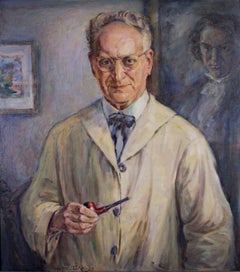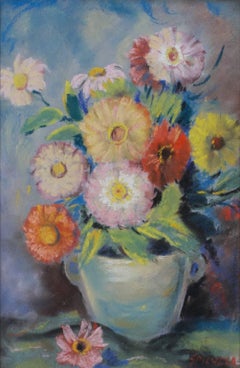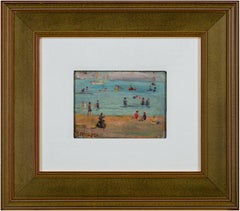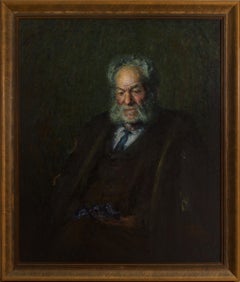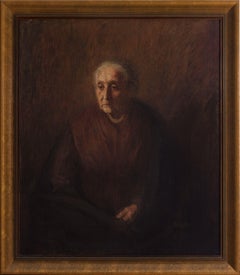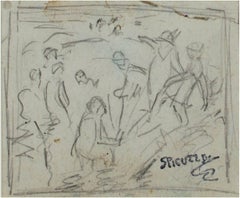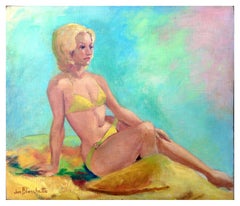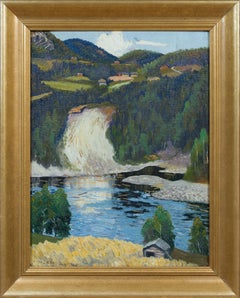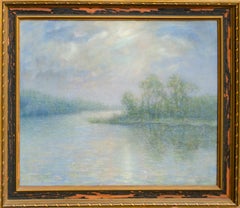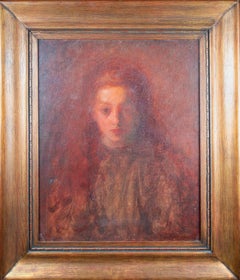Francesco Spicuzza Art
Italian, American, 1883-1962
Italian-born Francesco Spicuzza was primarily a Wisconsin painter who did portraits, still-lives and local landscapes. He spent the first part of his life in near-poverty to become a painter. An eternal optimist, in 1917, the artist reported: "I am happy and my only ambition now is to paint better and better until I shall have reached the measure of the best of which I am capable." (Spicuzza, 1917, p. 22). His predilection for beach scenes germinated early: reportedly, the five-year-old boy first drew the outlines of his father's fishing boat in the sand on the seashore near their home in Sicily. After setting himself up as a fruit peddler in Milwaukee, Spicuzza's father sent for his family when Francesco was eight years old.
In 1899 or 1900, Spicuzza began studying drawing and anatomy under Robert Schade (1861-1912), a painter of panoramas who had been trained in Munich under Carl Theodor von Piloty. Spicuzza was also taught by Alexander Mueller (1872-1935), a product of the Weimar and Munich academies.
The earliest influences in his work appear to be from Edward H. Potthast and Maurice Prendergast, though Spicuzza never mentioned either artist. Already in August 1910, Spicuzza was described in a newspaper as "one of the most talented of Milwaukee's rising workers." He undoubtedly received lasting inspiration from his one summer study period in 1911 with John F. Carlson at the Art Students League's Summer School in Woodstock, New York. Although he executed numerous still-lives and an occasional religious work, Spicuzza is best known for his Milwaukee beach scenes populated with frolicking bathers in multi-colored attire, not unlike the images of Potthast, who used a similar technique. These beach genre scenes reflect the attitude of American impressionists who depicted the more pleasant side of life.
Spicuzza manipulated a successful balance of rich pigment applied in varying degrees of impasto texture with subtle nuances of hue. Working all'aperto, he sought "the soft enticing shades of yellow, blue, green, pink and lavender . . . to get the effects of bright glistening summer air." (L.E.S., n.d.). As a painter whose color not only derived from direct observation but also from a personal theory of color symbolism, Spicuzza traded the linear approach of lithography for dynamic patches of brilliant color. Like Prendergast, he would often tilt the angle of the picture plane to bring the viewer's position above the scene.
Spicuzza spent a great deal of time painting en plein air and by 1925 he began summering at Big Cedar Lake, near West Bend, Wisconsin to gather his subject matter. During the difficult era of the Depression, patrons came to Spicuzza's aid and during the 40s, he taught housewives, businessmen and students at the Milwaukee Art Institute, the Milwaukee Art Center, and in his studio. In the following decade, although his kind of art was no longer popular in the "make-it-or-break-it" New York gallery world, Spicuzza enjoyed regular patronage and sales.
Bio by Richard H. Love and Michael Preston Worley, Ph.D.to
2
7
1
3
3
Overall Width
to
Overall Height
to
16
1
4
1
6
1
1
2
1
11
4
1
11
4
3
3
3
2
2
2
1
1
1
1
1
1
1
1
1
1
1
1
8
8
7
5
5
16
8,232
2,807
1,650
1,318
6
3
16
Artist: Francesco Spicuzza
20th century oil painting self portrait male subject glasses pipe signed
By Francesco Spicuzza
Located in Milwaukee, WI
"Self Portrait" is an original oil painting on masonite board by Francesco Spicuzza. The artist signed the piece in the lower left. It depicts the artist holding a pipe in front of a...
Category
1940s Francesco Spicuzza Art
Materials
Masonite, Oil
"Flowers in Vase with Handles, " Pastel on Paperboard signed by F. Spicuzza
By Francesco Spicuzza
Located in Milwaukee, WI
"Flowers in Vase with Handles" is an original pastel drawing on paperboard by Francesco Spicuzza. The artist signed the piece in the lower right. This drawing depicts a bouquet of wa...
Category
1930s Francesco Spicuzza Art
Materials
Paper, Pastel, Board
"Lake Michigan Beach Scene, " Oil on Canvas Seascape signed by Francesco Spicuzza
By Francesco Spicuzza
Located in Milwaukee, WI
"Lake Michigan Beach Scene" is an original oil painting by Francesco Spicuzza. The artist painted this scene on canvas and then glued that canvas to a b...
Category
1930s Francesco Spicuzza Art
Materials
Canvas, Oil, Board
20th century oil painting portrait realism male subject dark background signed
By Francesco Spicuzza
Located in Milwaukee, WI
Signed lower right by the artist.
Francesco J. Spicuzza, born in Sicily on July 23, 1883, came to America at the age of 8. He supported himself as a fruit peddler until a newspaperman gave him $4 a week to go to school. He attended classes at the Milwaukee Art Students League, where he studied under Alexander Mueller. There he learned to paint in the then-fashionable "Munich School" technique, with detailed realism in heavy browns and grayed-out hues. Spicuzza completed eight grades in four years, and then in 1911, three businessmen advanced him enough money to allow him to study in New York under artist and teacher John Carlson.
It was during this time that Spicuzza changed his style of painting, developing an impressionistic use of color, form and atmospheric renditions. After a period of grinding poverty, one of Spicuzza's pictures won a major New York competition. It was the first of 60 wins, both in the U.S. and Paris. He became a fashionable painter, and many of the leading collections have his work. Spicuzza's typical works were beach scenes, still life, landscapes and portraits done in pastels, oils, ink, charcoal and watercolors. Much of his work traced the history of Milwaukee in the early 1900s. He was probably best known for his scenes of women and children splashing in the waves...
Category
1910s Francesco Spicuzza Art
Materials
Oil
20th century oil painting portrait realism female subject dark background signed
By Francesco Spicuzza
Located in Milwaukee, WI
Signed lower right by the artist.
Francesco J. Spicuzza, born in Sicily on July 23, 1883, came to America at the age of 8. He supported himself as a fruit peddler until a newspaperman gave him $4 a week to go to school...
Category
1910s Francesco Spicuzza Art
Materials
Oil
"Lake Michigan Bathers, " Pencil, Reverse, & Photo signed by Francesco Spicuzza
By Francesco Spicuzza
Located in Milwaukee, WI
"Lake Michigan Bathers" is an original pencil sketch by Francesco Spicuzza. The artist signed the piece in the lower right. On the reverse is a silver gelatin photo print...
Category
1910s Francesco Spicuzza Art
Materials
Carbon Pencil, Black and White, Silver Gelatin
Beautiful large impressionist pastel by Francesco Spicuzza
By Francesco Spicuzza
Located in New York, NY
Francesco Spicuzza (American, 1883-1962)
Untitled Landscape, 20th century
Pastel on paper
Sight size: 24 x 30 in.
Framed: 26 1/4 x 32 3/8 in.
Signed lower right: Spicuzza
Italian-born Francesco Spicuzza was primarily a Wisconsin painter who did portraits, still-lives and local landscapes. He spent the first part of his life in near-poverty to become a painter. An eternal optimist, in 1917, the artist reported: "I am happy and my only ambition now is to paint better and better until I shall have reached the measure of the best of which I am capable." (Spicuzza, 1917, p. 22). His predilection for beach scenes germinated early: reportedly, the five-year-old boy first drew the outlines of his father's fishing boat in the sand on the seashore near their home in Sicily. After setting himself up as a fruit peddler in Milwaukee, Spicuzza's father sent for his family when Francesco was eight years old. For the following six years the boy was unable to attend school because of his job in his father's fruit and vegetable business. The poor lad suffered a caved-in shoulder from carrying a heavy wooden crate.
The young Spicuzza was aided by moral and financial support from a sympathetic Milwaukee businessman named John Cramer, publisher and editor of the Evening Wisconsin, who raised Spicuzza's salary as a newspaper assembler so that he could attend school. In 1899 or 1900, Spicuzza began studying drawing and anatomy under Robert Schade (1861-1912), a painter of panoramas who had been trained in Munich under Carl Theodor von Piloty. Spicuzza was also taught by Alexander Mueller (1872-1935), a product of the Weimar and Munich academies. Mueller realized Spicuzza was a colorist and encouraged that orientation (Madle, 1961). Spicuzza found it beneficial to accept an apprenticeship in a lithographic studio for $8 a week, which demanded most of his time. During the St. Louis Universal Exposition in 1904, still a struggling student, Spicuzza attended the fair, thanks to Cramer. It was not long before Spicuzza received a twenty-five dollar portrait commission, and this inaugural success led to new commissions and allowed him to continue as a painter.
The earliest influences in his work appear to be from Edward H. Potthast and Maurice Prendergast, though Spicuzza never mentioned either artist. Already in August 1910, Spicuzza was described in a newspaper as "one of the most talented of Milwaukee's rising workers." He undoubtedly received lasting inspiration from his one summer study period in 1911 with John F. Carlson at the Art Students League's Summer School in Woodstock, New York. Certainly Spicuzza would have picked up spontaneity in handling the brush from Carlson. Although he executed numerous still-lives and an occasional religious work, Spicuzza is best known for his Milwaukee beach scenes populated with frolicking bathers in multi-colored attire, not unlike the images of Potthast, who used a similar technique. Many of these are small, preparatory works on canvas board executed between 1910 and 1915. Frequently with even greater animation than Potthast, Spicuzza produced moving images of youthful energy and uninhibited child's play. These beach genre scenes reflect the attitude of American impressionists who depicted the more pleasant side of life.
Spicuzza manipulated a successful balance of rich pigment applied in varying degrees of impasto texture with subtle nuances of hue. Working all'aperto, he sought "the soft enticing shades of yellow, blue, green, pink and lavender . . . to get the effects of bright glistening summer air." (L.E.S., n.d.). As a painter whose color not only derived from direct observation but also from a personal theory of color symbolism, Spicuzza traded the linear approach of lithography for dynamic patches of brilliant color. Like Prendergast, he would often tilt the angle of the picture plane to bring the viewer's position above the scene.
Spicuzza was unable to enter the 1913 Armory Show or the Panama-Pacific International Exposition two years later but he did submit work to the annual exhibitions of the Pennsylvania Academy of the Fine Arts and those of the Art Institute of Chicago. His first important award was the bronze medal presented by the St. Paul Institute in 1913, which was followed by the silver medal two years later. Before long, Spicuzza had acquired a greater sense of security in his profession and was described by a writer in International Studio (April 1917) as "an independent artist with an assured future. His pastels and water-colours are poetic and joyous bits of nature with a genuine out-of-door feeling." In 1918, his Spirit of Youth, exhibited at the National Academy of Design, sold for $112.50. Four years later, the artist achieved his greatest local recognition by winning the gold medal from the Milwaukee Art Institute.
Spicuzza spent a great deal of time painting en plein air and by 1925 he began summering at Big Cedar Lake, near West Bend, Wisconsin to gather his subject matter. Easter Morning (1926) owes something to the Symbolist movement, with its figure of Christ appearing over a seascape. During the difficult era of the Depression, patrons came to Spicuzza's aid and during the 40s, he taught housewives, businessmen and students at the Milwaukee Art Institute, the Milwaukee Art Center, and in his private studio. In the following decade, although his kind of art was no longer popular in the "make-it-or-break-it" New York gallery world, Spicuzza enjoyed regular patronage and sales. His beach scenes became more static and he would experiment with modernist techniques. Spicuzza died at the age of seventy-eight.
Sources:
L.E.S., "Do Colors Change a Person's disposition? Experiments of a Milwaukee Artist...
Category
20th Century American Modern Francesco Spicuzza Art
Materials
Paper, Pastel
Early 20th century colorful seaside landscape pastel figures bench trees signed
By Francesco Spicuzza
Located in Milwaukee, WI
"Couple on Bench at the Beach" is an original pastel drawing on paperboard by Francesco Spicuzza. The artist signed the piece in the lower left. This drawing depicts two figures sitting on a bench in front of a body of water. The artist used mostly pastel colors for this piece.
6 7/8" x 9 7/8" art
18 1/2" x 21 3/8" frame
Francesco J. Spicuzza, born in Sicily on July 23, 1883, came to America at the age of 8. He supported himself as a fruit peddler until a newspaperman gave him $4 a week to go to school. He attended classes at the Milwaukee Art Students League, where he studied under Alexander Mueller. There he learned to paint in the then-fashionable "Munich School" technique, with detailed realism in heavy browns and grayed-out hues. Spicuzza completed eight grades in four years, and then in 1911, three businessmen advanced him enough money to allow him to study in New York under artist and teacher John Carlson. It was during this time that Spicuzza changed his style of painting, developing an impressionistic use of color, form and atmospheric renditions. After a period of grinding poverty, one of Spicuzza's pictures won a major New York competition. It was the first of 60 wins, both in the U.S. and Paris. He became a fashionable painter, and many of the leading collections have his work. Spicuzza's typical works were beach scenes, still life, landscapes and portraits done in pastels, oils, ink, charcoal and watercolors. Much of his work traced the history of Milwaukee in the early 1900s. He was probably best known for his scenes of women and children splashing in the waves...
Category
1910s Impressionist Francesco Spicuzza Art
Materials
Paper, Pastel, Board
"Lake Michigan Shore, " Oil on Board, Signed
By Francesco Spicuzza
Located in Milwaukee, WI
"Lake Michigan Shore" is an original oil painting on board by Francesco Spicuzza. The artist shows the impact of Impressionism in his landscapes from around 1930. "Lake Michigan Shor...
Category
1930s Francesco Spicuzza Art
Materials
Oil, Board
"Rocky Shore, " Oil on Board Abstract Landscape Signed
By Francesco Spicuzza
Located in Milwaukee, WI
"Rocky Shore" is an original oil painting on board by Francesco Spicuzza. The artist signed the piece with his signature stamp in the lower right. Land and water are clearly demarcat...
Category
1930s Francesco Spicuzza Art
Materials
Oil, Board
"Boats in Berlin Harbor, " Pastel on Cheesecloth by Francesco Spicuzza
By Francesco Spicuzza
Located in Milwaukee, WI
"Boats in Berlin Harbor" is an original pastel painting on cheesecloth. Small tugboats push across the Berlin harbor as a gauzy cityscape watches from behind.
Image: 25" x 33"
Frame...
Category
1920s American Modern Francesco Spicuzza Art
Materials
Pastel
"Cabin on Lake Michigan Shore, " Oil on Board signed by Francesco Spicuzza
By Francesco Spicuzza
Located in Milwaukee, WI
"Cabin on Lake Michigan Shore" is an original oil painting on board by Francesco Spicuzza. The artist signed the piece in the lower left. It depicts a small cabin on the lakeshore surrounded by bright vegetation.
14" x 20" art
22 3/4" x 29" frame
Francesco J. Spicuzza, born in Sicily on July 23, 1883, came to America at the age of 8. He supported himself as a fruit peddler until a newspaperman gave him $4 a week to go to school. He attended classes at the Milwaukee Art Students League, where he studied under Alexander Mueller. There he learned to paint in the then-fashionable "Munich School" technique, with detailed realism in heavy browns and grayed-out hues. Spicuzza completed eight grades in four years, and then in 1911, three businessmen advanced him enough money to allow him to study in New York under artist and teacher John Carlson. It was during this time that Spicuzza changed his style of painting, developing an impressionistic use of color, form and atmospheric renditions. After a period of grinding poverty, one of Spicuzza's pictures won a major New York competition. It was the first of 60 wins, both in the U.S. and Paris. He became a fashionable painter, and many of the leading collections have his work. Spicuzza's typical works were beach scenes, still life, landscapes and portraits done in pastels, oils, ink, charcoal and watercolors. Much of his work traced the history of Milwaukee in the early 1900s. He was probably best known for his scenes of women and children splashing in the waves...
Category
1930s Francesco Spicuzza Art
Materials
Oil, Board
Boy Launching a Sailboat
By Francesco Spicuzza
Located in Milwaukee, WI
Graphite and charcoal on paper signed by the artist.
7.38" x 8.63"
16.75" x 15.5" frame
Framed to conservation standards. Float mounted on 100% cotton matboard and glazed in UF5 Plexiglass that filters 99% of UV Rays to ensure the preservation of the piece. All housed in a bold miter jointed bevel frame in distressed silver finish with reflective accents.
Francesco J. Spicuzza, born in Sicily on July 23, 1883, came to America at the age of 8. He supported himself as a fruit peddler until a newspaperman gave him $4 a week to go to school. He attended classes at the Milwaukee Art Students League, where he studied under Alexander Mueller. There he learned to paint in the then-fashionable "Munich School" technique, with detailed realism in heavy browns and grayed-out hues. Spicuzza completed eight grades in four years, and then in 1911, three businessmen advanced him enough money to allow him to study in New York under artist and teacher John Carlson.
It was during this time that Spicuzza changed his style of painting, developing an impressionistic use of color, form and atmospheric renditions. After a period of grinding poverty, one of Spicuzza's pictures won a major New York competition. It was the first of 60 wins, both in the U.S. and Paris. He became a fashionable painter, and many of the leading collections have his work. Spicuzza's typical works were beach scenes, still life, landscapes and portraits done in pastels, oils, ink, charcoal and watercolors. Much of his work traced the history of Milwaukee in the early 1900s. He was probably best known for his scenes of women and children splashing in the waves...
Category
Mid-20th Century Francesco Spicuzza Art
Materials
Charcoal, Graphite
Mid 20th century black and white drawing landscape trees houses figures signed
By Francesco Spicuzza
Located in Milwaukee, WI
"Monkey Island at Washington Park Zoo" is an original graphite and charcoal drawing on paper by Francesco Spicuzza. It depicts a number of figures gazing out at a monkey enclosure at a zoo. The artist signed the piece in the lower left.
8 1/2" x 11 3/4" art
17 1/4" x 21 1/8" frame
Francesco J. Spicuzza, born in Sicily on July 23, 1883, came to America at the age of 8. He supported himself as a fruit peddler until a newspaperman gave him $4 a week to go to school. He attended classes at the Milwaukee Art Students League, where he studied under Alexander Mueller. There he learned to paint in the then-fashionable "Munich School" technique, with detailed realism in heavy browns and grayed-out hues. Spicuzza completed eight grades in four years, and then in 1911, three businessmen advanced him enough money to allow him to study in New York under artist and teacher John Carlson. It was during this time that Spicuzza changed his style of painting, developing an impressionistic use of color, form and atmospheric renditions. After a period of grinding poverty, one of Spicuzza's pictures won a major New York competition. It was the first of 60 wins, both in the U.S. and Paris. He became a fashionable painter, and many of the leading collections have his work. Spicuzza's typical works were beach scenes, still life, landscapes and portraits done in pastels, oils, ink, charcoal and watercolors. Much of his work traced the history of Milwaukee in the early 1900s. He was probably best known for his scenes of women and children splashing in...
Category
1950s Francesco Spicuzza Art
Materials
Paper, Charcoal, Graphite
"Snowcapped Mountain, " Oil on Board signed by Francesco Spicuzza
By Francesco Spicuzza
Located in Milwaukee, WI
"Snowcapped Mountain" is an original oil painting on board by Francesco Spicuzza. The artist signed it with his signature stamp in the lower left. This painting depicts a mountain pe...
Category
1930s Francesco Spicuzza Art
Materials
Oil, Board
20th century portrait oil painting female subject dark background signed
By Francesco Spicuzza
Located in Milwaukee, WI
"Portrait of the Artist's Mother-in-Law" is an original pastel drawing by Francesco Spicuzza. The artist signed the piece in the lower right. This drawing depicts an elderly woman in beige clothing...
Category
Early 1900s Francesco Spicuzza Art
Materials
Pastel
Related Items
Basking in the Sun - Mid Century Modern Multicolor Female Figurative
By Jon Blanchette
Located in Soquel, CA
Multi-colored figurative oil painting of a woman in bikini bathing in the California sun by listed California artist Jon Blanchette (American, 1908-1987). The colorful background is...
Category
1950s American Impressionist Francesco Spicuzza Art
Materials
Masonite, Oil
$1,440 Sale Price
20% Off
H 20 in W 24 in D 1 in
Waterfall and Timber – A View from Norrland
Located in Stockholm, SE
Provenance: Acquired directly from Katarina Gunnarsson, who inherited the painting from her mother, Barbro, the daughter of the artist.
This striking landscape by Oscar Lycke depict...
Category
Early 20th Century Post-Impressionist Francesco Spicuzza Art
Materials
Canvas, Oil, Board
A Young Girl Reading a Book, Pointillist Artist
Located in Stockholm, SE
"A Young Girl Reading a Book" is a captivating portrait by Swedish artist Gustaf Arnolds.
Arnolds was a prolific painter whose roots began in Vingåker and later in Ronneby from his teenage years.
His educational journey in art took him through prestigious institutions such as Althins målarskola and the Tallbergska grafikskolan in Stockholm,
followed by a significant period at the Konstakademien, Stockholm, between 1904 and 1909. His talent and dedication were recognized early on, earning him a scholarship to Paris, a city that would deeply influence his artistic direction.
This particular work, likely painted shortly after his return to Sweden, reveals a profound influence from his time in Paris. It portrays a young girl absorbed in reading a book, a simple yet profound subject that Arnolds imbues with a sense of tranquility and introspection. The background hints at a serene landscape, dotted with quaint houses, a nod to the everyday beauty surrounding us. What sets this piece apart is Arnolds’ technique, reminiscent of pointillism but distinguished by longer, more expressive brush strokes that add a vibrant texture and depth to the canvas. This method showcases Arnolds' unique adaptation of the techniques he encountered during his Parisian studies, particularly during his interactions with Nils Dardel...
Category
1930s Pointillist Francesco Spicuzza Art
Materials
Masonite, Oil
$1,730 Sale Price
20% Off
H 16.15 in W 13.39 in
Barcelona and Its People oil painting Spain
By Josep Martinez Lozano
Located in Barcelona, Barcelona
Title: Barcelona and Its People
Artist: Josep Maria Martínez Lozano (1923–2006)
Year: 1979
Technique: Oil on canvas mounted on board
Dimensions: 29.13 x 21.65 in
Condition: Unfr...
Category
1970s Expressionist Francesco Spicuzza Art
Materials
Canvas, Oil, Board
$1,321 Sale Price
26% Off
H 29.14 in W 21.66 in
River port oil painting european art seascape urbanscape France
By Rafael Duran Benet
Located in Barcelona, Barcelona
Rafael Duran Benet (1931-2015) - River port - Oil on canvas on board
Oil measurements 22x27 cm.
Frame 24x29.
Rafael Duran Benet (Terrassa, 1931 - Barcelona, 2015) is a Catalan paint...
Category
1960s Post-Impressionist Francesco Spicuzza Art
Materials
Canvas, Oil, Board
$528 Sale Price
26% Off
H 8.67 in W 10.63 in
Barcelona view urbanscape oil painting Spain spanish
By Josep Marfa Guarro
Located in Barcelona, Barcelona
Josep Marfa Guarro (1928-2014) Barcelona Spain Oil
Oil on canvas glued to cardboard.
Oil measures 23x28 cm. Frameless.
Josep Marfa Guarro (1928-2014)
Josep Marfa Guarro was a Cata...
Category
1990s Impressionist Francesco Spicuzza Art
Materials
Canvas, Oil, Cardboard
$324 Sale Price
46% Off
H 9.06 in W 11.03 in
In the Garden, 10x8" oil on board
By Lu Haskew
Located in Loveland, CO
In the Garden by Lu Haskew
Oil Painting of woman with an umbrella in a backyard garden
10x8" image size
14x12" framed
Shipping price includes the custom packing necessary for safe t...
Category
Early 2000s American Impressionist Francesco Spicuzza Art
Materials
Canvas, Oil, Board
G. A. Rochegrosse (1859-1938) A zither player, small signed drawingdrawing
By Georges Antoine Rochegrosse
Located in Paris, FR
Georges Antoine Rochegrosse (1859-1938)
A zither player
carbon pencil on thin paper
8.5 x 3.3 cm
In good condition
Framed : 35 x 24 cm
Provenance: Estate of the artist and by Inher...
Category
1910s Symbolist Francesco Spicuzza Art
Materials
Carbon Pencil
French School 19th Century, A Muskeeter, original pencil drawing
Located in Paris, FR
French school 19th Century
A Muskeeter
Pencil on paper
26.5 x 17 cm
Bears a signature "F. Roybet" in the lower right
In quite good condition, bears some visible foxings,
In an old mount (some damages)
(not framed)
Even if the style, execution and of course subject are those of Ferdinand Roybet...
Category
1890s Academic Francesco Spicuzza Art
Materials
Carbon Pencil
"Don't Cry Long" Abstracted and Distorted Self-Portrait, One Crying Eye
Located in Detroit, MI
"Don't Cry Long" is a self-portrait of the artist and an unusual one at that in which the artist portrays herself shedding tears. Perhaps it is an expression of some grief experienced by Ms. Woodlock, but it also admonishes her to not "Cry Long" while at the same time poking fun because of her elongated face and the one lone "long" tear tracing a pattern down her face. In addition to self-portraits, Ethelyn painted commissioned portraits. In this painting her head is cocked and her famous bangs hang down her forehead. Compare two self-portraits, “Up From Under”, and “M’Eyes" to "Don't Cry Long." The major differences are the close facial view and the brilliant blood red paint that fills the entire canvas.
This painting is included in the book, "Dreams Have Wings: An Artist's Journey into Magic and Mystery" printed in the United States, 1985. She describes "Don't Cry Long" as showing how funny looking we are, if we cry too long.
Ethelyn Woodlock...
Category
Mid-20th Century American Modern Francesco Spicuzza Art
Materials
Oil, Masonite
Allegory of Love, Cupid With Beauty in Fine Dress Carrying a Basket of Flowers
Located in Cotignac, FR
A late 18th Century oil on canvas laid on board of a young beauty in period costume carrying a basket of flowers on her head. Presented in a very fine gilt, period 'Directoire' frame...
Category
Late 18th Century Romantic Francesco Spicuzza Art
Materials
Canvas, Oil, Board
$1,441
H 13.39 in W 11.23 in D 1.19 in
Park in a Catalan City oil painting spanish urbanscape
By Sebastia Congost i Pla
Located in Barcelona, Barcelona
ChatGPT Plus
Title: Park in a Catalan City
Artist: Sebastià Congost Pla (1919–2009)
Technique: Oil on canvas-mounted hardboard
Dimensions: 24 x 33 cm
Framed dimensions: 34 x 43 cm
Si...
Category
1970s Post-Impressionist Francesco Spicuzza Art
Materials
Canvas, Oil, Board
$576 Sale Price
20% Off
H 9.45 in W 13 in
Previously Available Items
Lovely impressionist landscape in pastel by Francesco Spicuzza
By Francesco Spicuzza
Located in New York, NY
Francesco Spicuzza (American, 1883-1962)
Untitled Landscape, 20th century
Pastel on paper
Sight size: 25 x 29 1/2 in.
Framed: 30 3/4 x 35 1/2 in.
Signed lower right: Spicuzza
Italian-born Francesco Spicuzza was primarily a Wisconsin painter who did portraits, still-lives and local landscapes. He spent the first part of his life in near-poverty to become a painter. An eternal optimist, in 1917, the artist reported: "I am happy and my only ambition now is to paint better and better until I shall have reached the measure of the best of which I am capable." (Spicuzza, 1917, p. 22). His predilection for beach scenes germinated early: reportedly, the five-year-old boy first drew the outlines of his father's fishing boat in the sand on the seashore near their home in Sicily. After setting himself up as a fruit peddler in Milwaukee, Spicuzza's father sent for his family when Francesco was eight years old. For the following six years the boy was unable to attend school because of his job in his father's fruit and vegetable business. The poor lad suffered a caved-in shoulder from carrying a heavy wooden crate.
The young Spicuzza was aided by moral and financial support from a sympathetic Milwaukee businessman named John Cramer, publisher and editor of the Evening Wisconsin, who raised Spicuzza's salary as a newspaper assembler so that he could attend school. In 1899 or 1900, Spicuzza began studying drawing and anatomy under Robert Schade...
Category
20th Century American Modern Francesco Spicuzza Art
Materials
Paper, Pastel
H 30.75 in W 35.5 in D 0.75 in
'Little Mary Spicuzza' signed oil painting of the artist's niece
By Francesco Spicuzza
Located in Milwaukee, WI
In this haunting yet adoring portrait, Francesco Spicuzza presents to the viewer his niece Mary. Her young face, probably from when about six years old, emerges from a hazy buildup o...
Category
1910s American Impressionist Francesco Spicuzza Art
Materials
Canvas, Oil
"Floral, " Pastel Vivid Still-life of Flowers signed by Francesco Spicuzza
By Francesco Spicuzza
Located in Milwaukee, WI
"Floral" is an original pastel drawing on paper by Francesco Spicuzza, signed in the lower right. The piece is a still life, a bouquet of flowers in a vase on the table. The perspec...
Category
1920s Modern Francesco Spicuzza Art
Materials
Paper, Pastel
"Boy Launching Toy Sailboat 353, " Original Graphite signed by Francesco Spicuzza
By Francesco Spicuzza
Located in Milwaukee, WI
"Boy Launching Toy Sailboat #353" is an original graphite drawing on paper by Francesco Spicuzza, stamped with his signature in the lower left. Executed i...
Category
1940s Modern Francesco Spicuzza Art
Materials
Paper, Graphite
Flowers in Blue Vase
By Francesco Spicuzza
Located in Milwaukee, WI
"Flowers in Blue Vase" is an original pastel drawing on paperboard by Francesco Spicuzza. The artist signed the piece in the lower right. This dra...
Category
1930s Francesco Spicuzza Art
Materials
Paper, Pastel, Board
Francesco Spicuzza art for sale on 1stDibs.
Find a wide variety of authentic Francesco Spicuzza art available for sale on 1stDibs. You can also browse by medium to find art by Francesco Spicuzza in oil paint, paint, board and more. Much of the original work by this artist or collective was created during the 20th century and is mostly associated with the modern style. Not every interior allows for large Francesco Spicuzza art, so small editions measuring 13 inches across are available. Customers who are interested in this artist might also find the work of Leon Kelly, Frank Wilcox, and Abraham Walkowitz. Francesco Spicuzza art prices can differ depending upon medium, time period and other attributes. On 1stDibs, the price for these items starts at $2,025 and tops out at $33,000, while the average work can sell for $5,788.
